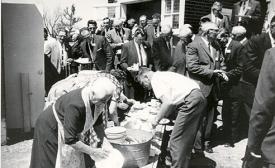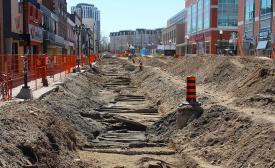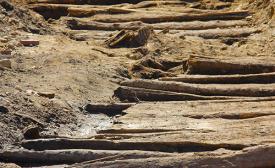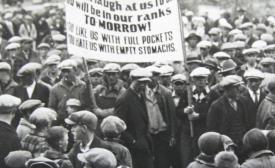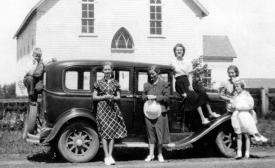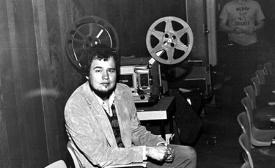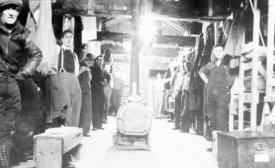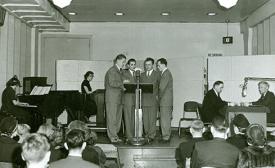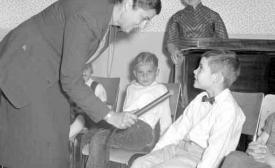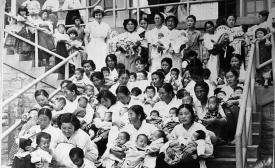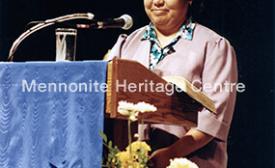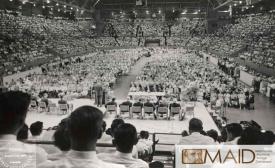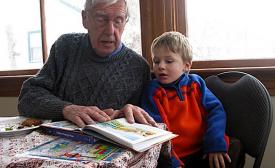history
Naomi Martin
Mennonite ‘routes’ go deep
Building of a light-rail transit system along the spine of Waterloo and Kitchener had to change focus in March 2016, when excavations in uptown Waterloo exposed the remains of a corduroy road. Archeologists are dating the road to the late 1700s or early 1800s. It was probably built by Mennonites, the original settlers in the area.
Researching the past to understand the present

Stefan Epp-Koop is the author of We're Going to Run This City: Winnipeg's Political Left after the General Strike. (Photo by Aaron Epp)
“Why couldn’t I have been more interested in Caribbean history?”
That’s what historian Stefan Epp-Koop asked himself during a December 2007 visit to Winnipeg, as he trudged through a deep layer of fresh snow in -30 C weather to the City of Winnipeg Archives.
Funk family goes to church
This is a photo of Mennonite writer Katie Funk Wiebe and her family driving to church circa 1940. Katie’s father, Jacob J. Funk, took the picture in front of Eigenheim Mennonite Church in Saskatchewan. Pictured from left to right: Jakie, Katie, mother Anna with her Sunday hat, Frieda, Annie and Susie. The Eigenheim church began services in 1892 and formally organized in 1894.
Film-maker Allan Kroeker
Do you enjoy the TV show Star Trek? If so, thank Allan Kroeker, who directed 39 episodes between 1996 and 2005. Kroeker continues to direct and this year is working on two projects. Kroeker began producing for Mennonite Brethren Communications in 1976, Mennonite Central Committee, and MBMSI. Kroeker grew up in Winnipeg, Man., and credits his grandfather A.A.
CO Bunkhouse
Second World War conscientious objectors (COs) were often sent to provincial parks for manual labour, as part of their alternative service assignments. This photo, taken between 1941-45, depicts Mennonite men getting dressed in their winter clothes around the warmth of a wood stove. Smoke from the stove, with laundry hanging from the rafters, can be seen in the background.
1960s radio broadcast of a men's quartet
This photo is of a men’s quartet singing for a radio broadcast in a Vancouver Mennonite church basement circa the 1960s. Advances in mass communication such as radio were first met with suspicion and in some cases were banned in Mennonite communities warning about worldly influences entering the home and community. Committees were established to consider the best response to these innovations.
Radio host Esther Horch, 1958
Radio host Esther Horch interviews school children live on a Saturday morning broadcast of Children’s Party in 1958. This education and entertainment show for children aired daily on CFAM from Altona, Man. Founded in 1956 by Mennonite shareholders, CFAM could reach 90 percent of Manitoba’s population.
Nurse Katherine Dyck, 1956
Mennonite Central Committee nurse Katherine Dyck poses with mothers and twins in Pusan, Korea, in 1956. Born in Russia in 1925, she immigrated to Rosthern, Sask., and worked as a nurse in Saskatchewan and Maryland before beginning service in Korea in 1953.
Anna Thiessen, Winnipeg missionary
Missionary to the city of Winnipeg, Anna Thiessen, is seated with some girls she worked with in 1919. Rural life has been an important part of Mennonite life and self-understanding. The city was seen as dangerous and unhealthy and therefore shunned. Mennonite Brethren missionary Anna Thiessen was one of the first Canadian Mennonites who chose to work in the city, beginning in 1915.
Sunday School in 1980
A group of children from Orchard Park Bible Church in Niagara-on-the-Lake, Ont., carry signs celebrating the 200th birthday of Sunday school as Kathy and Alfred Guenther present keepsakes to the children. In 1780, Robert Raikes started Sunday school in Gloucester, England, as a way to teach lower-class children morals and religion.
Lenore Mendes at Mennonite World Conference, 1990
Lenore Mendes of Guatemala addresses Mennonite World Conference 12 in Winnipeg in 1990. She thought she would be speaking to a few hundred people, but was surprised to see thousands. The Winnipeg gathering was the biggest to date with 13,000 registrants. Her sermon in Winnipeg was an important stepping stone to her election to the Executive Committee of MWC.
On the way to Sängerfest, 1934
A group of 18 young men and women travel in the back of a truck on their way a Sängerfest or song festival in the Didsbury, Alberta, area in 1934. No seatbelts used here! Song festivals were popular in Mennonite circles as a way of gathering to see old friends, enjoy singing four-part harmony music, and a way for young men and women to meet in controlled environments.
Mennonite World Conference, 1962
We Shall Remain

We Shall Remain is the title of a documentary series by PBS. We watched a few of the episodes while living in Virginia, where we heard very little of indigenous people, culture, or history. Whenever we asked about it, people we talked to said, "oh yeah, there used to be lots of indigenous people in this area" and would point to the main highways running through as ancient trade routes and the name of the valley "Shenandoah" as an indigenous name.
Stories of Salvation
Blame. Hatred. Lament. Ignorance. Shame. Defense. It might just seem like stories of the past, but the struggle for history brings out deep feelings, as I discovered in our visit last year to Kyoto.
Never Again
Charlie Clark, who grew up in the United Church tradition, listened carefully to the stories of his beloved Grandpa Ritchie on his fruit orchard in Naramata, B.C. The stories came from a gentle man who had seen war up close and who believed there was a better way to solving problems.
60 Years from Now...
Two women, working as "maids" in 1960's segregated southern United States, cross racial lines to take a risk in telling their stories to an eager young writer.
Watching "The Help" in Virginia, I couldn't help but wonder about the impact of such a film in what was the historic "south."
When you come . . .
Meet me at the Grand!

A 1797 Conestoga wagon, refitted with rubber tires, travels from Lancaster, Pa., to Kitchener-Waterloo, Ont., in 1952 to mark the centennial of Waterloo County. (File photo by David Hunsberger, Mennonite Archives of Ontario)
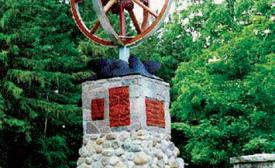
A cairn erected at The First Mennonite Church in Vineland in 1986 marks the bicentennial celebrations of the Mennonites’ arrival in Canada. (www.gameo.org photo)
It is 1786. The first Swiss Mennonites have just arrived in Ontario, having travelled from Pennsylvania in Conestoga wagons. They crossed the mighty Niagara River by taking the wheels off their wagons, sealing the wagon boxes to make boats, and then floating across. Cattle and horses swam.
Pages
- « first
- ‹ previous
- 1
- 2
- 3

